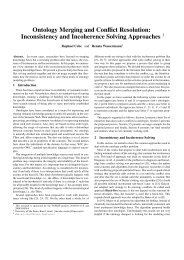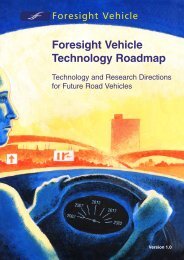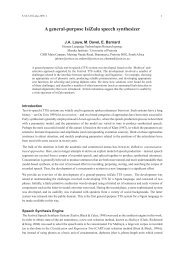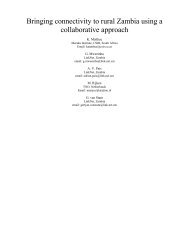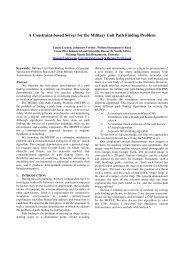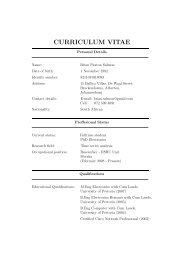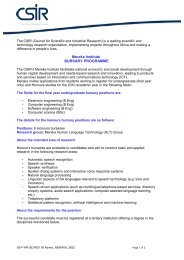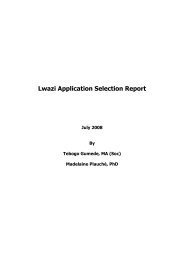Initial fieldwork for LWAZI: A telephone-based ... - Meraka Institute
Initial fieldwork for LWAZI: A telephone-based ... - Meraka Institute
Initial fieldwork for LWAZI: A telephone-based ... - Meraka Institute
Create successful ePaper yourself
Turn your PDF publications into a flip-book with our unique Google optimized e-Paper software.
<strong>Initial</strong> <strong>fieldwork</strong> <strong>for</strong> <strong>LWAZI</strong>: A <strong>telephone</strong>-<strong>based</strong> spoken dialog<br />
system <strong>for</strong> rural South Africa<br />
Tebogo Gumede<br />
CSIR<br />
<strong>Meraka</strong> <strong>Institute</strong><br />
P. O Box 395<br />
Pretoria, 0001<br />
tgumede@csir.co.za<br />
Abstract<br />
This paper describes sociological<br />
<strong>fieldwork</strong> conducted in the autumn of 2008<br />
in eleven rural communities of South<br />
Africa. The goal of the <strong>fieldwork</strong> was to<br />
evaluate the potential role of automated<br />
telephony services in improving access to<br />
important government in<strong>for</strong>mation and<br />
services. Our interviews, focus group<br />
discussions and surveys revealed that<br />
<strong>LWAZI</strong>, a <strong>telephone</strong>-<strong>based</strong> spoken dialog<br />
system, could greatly support current<br />
South African government ef<strong>for</strong>ts to<br />
effectively connect citizens to available<br />
services, provided such services be toll<br />
free, in local languages, and with content<br />
relevant to each community.<br />
1. Introduction<br />
There is a growing interest in deploying spoken<br />
dialog systems in developing regions. In rural<br />
communities of developing regions, where<br />
infrastructure, distances, language and literacy<br />
are barriers to access, but where mobile phones<br />
are prevalent, spoken dialog systems could be<br />
key to unlocking social and economic growth.<br />
Some notable recent studies in this field include<br />
“Tamil Market” (Plauche et al., 2006) and<br />
“VoiKiosk” (Agarwal et al., 2008), kiosk-<strong>based</strong><br />
spoken dialog systems providing agricultural<br />
in<strong>for</strong>mation that were tested in rural, semiliterate<br />
communities in India. Nas<strong>for</strong>s (2007)<br />
also developed an agricultural in<strong>for</strong>mation<br />
service, aimed at mobile <strong>telephone</strong> users and<br />
deployed in Kenya. In the health domain, spoken<br />
dialog systems have been recently employed to<br />
support community health workers in Pakistan<br />
Madelaine Plauché<br />
CSIR<br />
<strong>Meraka</strong> <strong>Institute</strong><br />
PO Box 395<br />
Pretoria, 0001<br />
mad@brainhotel.org<br />
(Sherwani et al., 2007) and caregivers of HIV<br />
positive children in Botswana (Sharma et al.,<br />
2008). In this paper, we expand on the<br />
preliminary experiments of Barnard et al. (2003)<br />
and this growing body of work by investigating<br />
the role <strong>for</strong> spoken dialog systems in connecting<br />
rural citizens of South Africa with government<br />
services, such as free education opportunities<br />
and stipends.<br />
South Africa is the leader in In<strong>for</strong>mation<br />
and Communications Technology (ICT) in<br />
Africa and has the most developed<br />
telecommunications network on the continent<br />
(South African year book 2006/2007: 131). In<br />
particular, mobile phone usage has experienced<br />
massive growth due in part to its accessibility by<br />
non-literate people and its “leapfrog”<br />
development, which skipped the interim<br />
solutions adopted in the developed world<br />
(Tongia & Subrahmanian, 2006). The amount of<br />
mobile phone users in South Africa is an<br />
astonishing 30 million people - out of a total<br />
population of 47 million (Benjamin, 2007). The<br />
percentage of both rural and urban households<br />
with mobile phones tripled from 2001 to 2007,<br />
while “landline” use declined. The accessibility<br />
and widespread use of mobile phones make<br />
spoken dialog systems a good candidate <strong>for</strong> lowcost<br />
in<strong>for</strong>mation access.<br />
In addition, <strong>telephone</strong>-<strong>based</strong> spoken<br />
dialog systems overcome barriers of language<br />
and literacy. In South Africa, there are eleven<br />
official languages. Private companies, NGOs and<br />
government offices who wish to reach South<br />
Africans through print or audio, find it extremely<br />
costly to do so <strong>for</strong> each language. Heugh (2007)<br />
shows that in terms of speakers' proficiency,<br />
1
there is no single lingua franca <strong>for</strong> South<br />
Africans (see Figure 1). In fact, less than half of<br />
South Africans understand English, the language<br />
in which most government messages are<br />
currently disseminated (Heugh 2007:PANSALB<br />
2001).<br />
35<br />
30<br />
25<br />
20<br />
15<br />
10<br />
5<br />
0<br />
Language proficiency in relation to age<br />
Afrikaans English Xhosa Zulu<br />
Language<br />
Figure 1: Language proficiency of South Africans.<br />
16-17 years<br />
18-24 years<br />
25-34 years<br />
35-44 years<br />
45-54 years<br />
55 + years<br />
Heugh (2007) also reports that between 35% and<br />
45% of South Africans above the age of 16<br />
cannot read or write. Illiteracy is<br />
disproportionately high <strong>for</strong> women and <strong>for</strong><br />
people living in the primarily rural provinces:<br />
KwaZulu-Natal, Limpopo and Mpumalanga.<br />
Mobile phone use is widespread in these areas<br />
among semi-literate citizens and speakers of all<br />
languages.<br />
Communities in rural areas struggle to<br />
access government services due to their remote<br />
locations. Most community members must travel<br />
long distances by foot or rare and costly public<br />
transport to access basic services. In their<br />
longitudinal household study on the costs and<br />
strategies of coping with chronic illnesses<br />
Goudge et al. (2007), <strong>for</strong> example, found that<br />
people in rural areas of South Africa do not go to<br />
free health care facilities because they cannot<br />
af<strong>for</strong>d transport.<br />
NGOs face the same challenge when<br />
trying to reach rural populations. Many produce<br />
in<strong>for</strong>mation to assist households affected by<br />
HIV/AIDS, <strong>for</strong> example, but most of the<br />
materials are published on websites; the cost of<br />
providing multilingual print materials is often<br />
too high. Due to low literacy levels, language,<br />
and a lack of infrastructure, the in<strong>for</strong>mation<br />
remains inaccessible to the people who need it,<br />
especially those living in rural areas and<br />
townships (Benjamin, 2007).<br />
Given the well developed mobile phone<br />
network and the relatively sparse alternative<br />
options in rural South Africa, the authors believe<br />
that multilingual spoken dialog systems can<br />
provide a low-cost solution to improving the ICT<br />
access of citizens who may currently be<br />
excluded from government services due to<br />
language, literacy and location. However, it is<br />
imperative to understand the target users and<br />
their environmental context as a first step to<br />
designing such a system (Nielsen, 1993). In this<br />
paper, we provide background on the current<br />
state of rural government service delivery in<br />
South Africa and introduce the <strong>LWAZI</strong> project,<br />
we describe our field methods, and finally, we<br />
present our findings from the initial field work<br />
with design implications <strong>for</strong> the <strong>LWAZI</strong> system.<br />
2. Background<br />
In South Africa, rural citizens are faced with a<br />
lack of economic activities and limited access to<br />
resources. These include access to basic services<br />
such as health care, legal advice, water,<br />
sanitation and in<strong>for</strong>mation. The government of<br />
South Africa is aware of these problems and<br />
offers many services to stimulate social and<br />
economic growth throughout the country. For<br />
example, citizens are eligible <strong>for</strong> free health care<br />
at certain clinics, free education <strong>for</strong> children and<br />
adults, free job training, foster grants, and<br />
financial aid <strong>for</strong> veterans, students, children, the<br />
disabled, and the elderly. However, rural citizens<br />
participate less in the services due to the long<br />
distances they are required to travel and in many<br />
cases, their lack of knowledge about the<br />
existence of such services. The South African<br />
government is aware of the need to improve<br />
citizen access to services, as well as the specific<br />
challenges that rural communities face. In this<br />
section, we describe the particular ICT project<br />
known as <strong>LWAZI</strong> (section 2.1) which is a<br />
system designed to add to government’s<br />
accessibility by eligible citizens.<br />
2.1 Project Lwazi<br />
2
As part of the great ICT initiative, an ambitious,<br />
three-year project is currently being conducted<br />
by the Human Language Technology (HLT)<br />
research group under the <strong>Meraka</strong> institute, at the<br />
Council <strong>for</strong> Scientific and Industrial Research<br />
(CSIR) in South Africa. This project is funded<br />
by the South African Department of Arts and<br />
Culture to develop a multilingual <strong>telephone</strong><strong>based</strong><br />
spoken dialog system that would assist<br />
South African government service delivery.<br />
“Lwazi,” derived from the IsiZulu word <strong>for</strong><br />
knowledge, aims to make a positive impact in the<br />
daily lives of South Africans by connecting them<br />
to the government and health services (Lwazi,<br />
2008). The HLT group is currently developing<br />
speech and language technologies (including<br />
speech recognition, text-to-speech and telephony<br />
plat<strong>for</strong>ms) <strong>for</strong> limited-resource languages. The<br />
ability of spoken dialog systems, powered by<br />
such technologies, to overcome barriers of<br />
language, literacy, and distances, led the Lwazi<br />
team to explore a low-cost application. This<br />
application will be modelled after and support<br />
the current successful, national initiatives (e.g.,<br />
TSCs, CDWs) operating primarily in rural areas.<br />
3. Method<br />
Eleven community-<strong>based</strong> centres in six of the<br />
nine provinces were visited by small, interdisciplinary<br />
teams of researchers over a period of 3<br />
months in the year 2008. Of these eleven<br />
centres, three were in peri-urban societies and<br />
the rest were <strong>based</strong> in rural settings. In each visit,<br />
the Lwazi team gained access to the community<br />
through the Thusong service centres<br />
(TSC’s) manager. These individuals provided<br />
materials, connections with key people at the<br />
TSC, CDWs, and access to community members.<br />
They also provided their office space <strong>for</strong><br />
these researchers to conduct meetings and interviews.<br />
We conducted key in<strong>for</strong>mant interviews,<br />
focused group discussions, and community and<br />
household interviews in each community. We especially<br />
met with government workers charged<br />
with disseminating in<strong>for</strong>mation to the community<br />
and community members who received<br />
services and in<strong>for</strong>mation. Data collection in<br />
these communities was primarily to investigate<br />
the suitability of the Lwazi spoken dialog system<br />
and to determine key user and contextual factors<br />
that would drive its design. In particular, we<br />
sought to:<br />
● Gather rural community in<strong>for</strong>mation needs.<br />
● Investigate how people currently get in<strong>for</strong>mation.<br />
● Determine which cultural factors would impact<br />
the Lwazi system.<br />
● Determine level of technical competency.<br />
● Gauge both interest in a Lwazi spoken dialog<br />
system and belief that such a system will be<br />
useful in improving livelihoods and access to<br />
government services.<br />
4. Results<br />
The <strong>LWAZI</strong> spoken dialog system must adhere<br />
to international standards wherever possible<br />
(Suhm, 2008; Nielsen, 1993). In many cases,<br />
however, the rural context of a developing region<br />
may present unique design challenges. For<br />
example, in Sharma et al. (submitted), it was<br />
found that among semi-literate women of neighbouring<br />
Botswana, pressing buttons and using<br />
speech to navigate a spoken dialog system was<br />
equally effective, but that unlike users in the developed<br />
world who preferred speech input, the<br />
users of Botswana preferred pressing buttons <strong>for</strong><br />
reasons of accuracy and privacy. In this section,<br />
we present our results from field visits in eleven<br />
communities of South Africa. In particular, we<br />
report on factors that influence the design and<br />
potential uptake of the Lwazi spoken dialog system<br />
in this context: the in<strong>for</strong>mation needs and<br />
sources (Section 4.1), cultural and social factors<br />
(Section 4.2), suitability of the technology (Section<br />
4.3), and user experience (Section 4.4).<br />
We conducted between one and five key<br />
in<strong>for</strong>mant interviews at each site. The interviews<br />
were generally conducted with the TSC<br />
manager, other employees of the TSC, CDWs of<br />
the community, and community members. In<br />
four of the eleven sites, we also conducted a<br />
focus group discussion. In two sites, we<br />
3
shadowed a CDW during a typical day and we<br />
toured the communities, including visiting farms,<br />
day-care centres, churches, markets, youth<br />
centres, clinics, businesses and households.<br />
The eleven communities we visited were<br />
located throughout eight of the nine provinces of<br />
South Africa. They varied greatly in available<br />
infrastructure and language spoken. They shared<br />
an economic dependency on nearby cities and, in<br />
some cases, reported social problems. These<br />
communities also share a dependency on<br />
government social grant. As mentioned above,<br />
because of high levels of unemployment, these<br />
community’s livelihoods is sustained by grants<br />
from government.<br />
Number of communities<br />
9<br />
8<br />
7<br />
6<br />
5<br />
4<br />
3<br />
2<br />
1<br />
0<br />
Primary problems in the 11 communities visited<br />
6<br />
Access to<br />
services such<br />
as health,<br />
social<br />
1<br />
Orphans<br />
8<br />
Unemployment<br />
Type of problem<br />
5<br />
Crime<br />
4<br />
Alcohol and<br />
drug abuse<br />
Figure 2: Number of the eleven communities that<br />
site these as primary problems in the community,<br />
as reported by interviewees.<br />
There are four mobile providers in South<br />
Africa namely Cell-C, MTN, Virgin Mobile and<br />
Vodacom. The two landline companies, Neo-tell<br />
and Telkom are not familiar in the communities<br />
visited by Lwazi team. Community members<br />
prefer and use mobile phones because of ease of<br />
use and accessibility. Figure 3 illustrates the use<br />
of mobile providers in the eleven visited<br />
communities.<br />
Number of communities<br />
12<br />
10<br />
8<br />
6<br />
4<br />
2<br />
0<br />
Mobile provider in communities visited<br />
Cell-C MTN Virgin Vodacom<br />
Mobile providers<br />
Figure 3: Mobile provider in communities visited<br />
Figure 4 below shows that all eleven<br />
communities visited received government<br />
in<strong>for</strong>mation through print. This, as mentioned<br />
earlier, is one of the problems the government is<br />
trying to address because of a high illiterate<br />
number. The second commonly used source of<br />
in<strong>for</strong>mation was the community development<br />
workers. This is a useful source because they are<br />
the ‘foot soldiers’ of the government; they are<br />
responsible <strong>for</strong> door to door visits, collecting and<br />
delivering in<strong>for</strong>mation. This source has its own<br />
challenges as discussed above.<br />
Number of communities<br />
12<br />
10<br />
8<br />
6<br />
4<br />
2<br />
0<br />
CDW<br />
Sources of government in<strong>for</strong>mation<br />
Public<br />
meetings<br />
local radio<br />
station in<br />
local language<br />
Sources of in<strong>for</strong>mation<br />
Print media<br />
Government<br />
print<br />
(including<br />
Vukuzenzele)<br />
Figure 4: sources of government in<strong>for</strong>mation<br />
4.1. In<strong>for</strong>mation Needs and Sources<br />
The majority of communities report a lack of<br />
economic activity as the primary problem in the<br />
community, and as could be expected, we<br />
observed very high levels of unemployment. .<br />
Grants are offered by the South African<br />
government to address the imbalance and<br />
4
stimulate the economy of these areas. There are<br />
six types of grants, namely: War Veteran grant,<br />
Old Age grant, Disability grant, Care<br />
dependency grant, Foster care grant and Child<br />
support grant. Citizens can apply <strong>for</strong> these at<br />
their nearest local South African social security<br />
agency (SASSA) or district office. The<br />
qualifying ages are as follows:<br />
Type of pension<br />
Old Age<br />
War Veteran<br />
Qualifying age<br />
For female 60 years and<br />
above, male 65 years<br />
and older<br />
60 years and older, or<br />
veterans under 60 due<br />
to medical reasons.<br />
Disability Between the ages of 18<br />
and 60 if female and 18<br />
and 65 years if male.<br />
Care dependency Between the ages of 1<br />
and 18 years.<br />
Foster care Between the ages of 0<br />
and 18 years<br />
Extension order<br />
Can be given until the<br />
age of 21 years.<br />
Child support grant- Between the ages of 0<br />
and 14 years<br />
Table 1: Government grants qualifying ages<br />
There are various supporting documents<br />
needed to apply <strong>for</strong> these grants. In<strong>for</strong>mation on<br />
these and other services was initially only<br />
accessible in writing and in English, which<br />
excluded the majority of the population. In<br />
addition, this in<strong>for</strong>mation was only available at<br />
certain locations (e.g. government department<br />
offices). In many communities we visited, social<br />
grants were by far the primary source of income<br />
<strong>for</strong> the community, after remittance (money sent<br />
home from family in nearby cities). Community<br />
members of all ages depend on these grants and<br />
want to be updated regularly about the<br />
developments of social grant policy. We found,<br />
however, that in addition to social services, the<br />
older population is also interested in local<br />
politics; young people are more interested in<br />
entertainment and employment opportunities and<br />
the social service services (Gumede, Plauche and<br />
Sharma, 2008).<br />
At the time of the visits, these<br />
communities received in<strong>for</strong>mation from the<br />
Thusong Service Centres. Government<br />
departments, NGOs, municipalities and research<br />
institutes such the CSIR, used the TSCs as a<br />
plat<strong>for</strong>m to disseminate in<strong>for</strong>mation. At a more<br />
grass roots level, African communities in South<br />
Africa share in<strong>for</strong>mation by word of mouth.<br />
This has lead to in<strong>for</strong>mation being shared via<br />
local radio stations and newspapers in local<br />
languages. Following is a case study illustrating<br />
a typical scenario.<br />
CASE STUDY<br />
Kgautswane is a village near Ohrigstad in the<br />
Limpopo province. According to the<br />
community development worker, the youth in<br />
this community are “lazy”. She said that there<br />
usually are a number of employment<br />
opportunities advertised in local newspapers<br />
and municipal offices, but they never apply. A<br />
majority of them are not computer literate so<br />
they receive news via local radio and word of<br />
month. A few of them use the Thusong<br />
Service Centre as it has a soccer field, hall,<br />
computer centre and NGOs who do<br />
community projects and employ people via the<br />
centre. The CDW’s conducts ‘door to door’<br />
visits to households to ensure that all those<br />
who are eligible <strong>for</strong> a grant is registered to<br />
receive it and is actually receiving it. They<br />
also ensure that all disasters are reported to the<br />
relevant authorities. The CDW must pay <strong>for</strong><br />
her own transportation and mobile phone bill.<br />
A free spoken dialog system that could<br />
broadcast announcements to her community<br />
members and allow her to connect directly<br />
with different government departments <strong>for</strong><br />
reports or inquiries would greatly facilitate her<br />
job.<br />
4.2 Cultural and Social Factors<br />
The population in these communities is<br />
usually older people taking care of grandchildren<br />
whose parents work in nearby cities and visit<br />
5
once or twice a year. As we have previously<br />
mentioned, the lack of economic activity means<br />
that these communities depend heavily on<br />
government social grants. Older people in these<br />
communities are often unable to read and write.<br />
In some cases, their limited eyesight restricts<br />
their ability to use the cheaper “texting” feature<br />
of their mobile phones. In the communities we<br />
visited, ten out of the eleven official South<br />
African languages were spoken. Each<br />
community typically spoke two or more<br />
languages, not necessarily the historically<br />
dominant languages (Afrikaans and English). A<br />
<strong>LWAZI</strong> system that delivered in<strong>for</strong>mation about<br />
SASSA services would be more accessible to the<br />
older, rural population than current methods;<br />
however, it must support all eleven languages or<br />
at least a majority of them in order to be usable.<br />
4.3 Suitability of Technology<br />
The investigation prior to the design of<br />
the Lwazi system investigates how to ensure that<br />
the proposed system will be suitable to the<br />
lifestyle of the community to be served. We do<br />
know that currently, communities have other<br />
means of accessing government in<strong>for</strong>mation,<br />
including the free “Vukuzenzele” monthly<br />
magazine and local radio stations. Like these<br />
current means, Lwazi must be free in order to be<br />
effective and it must contain locally-relevant<br />
content in order to be useful to these poor<br />
communities. Government departments will find<br />
<strong>LWAZI</strong> to be a very useful and low-cost way of<br />
disseminating their in<strong>for</strong>mation. Rural South<br />
Africans will benefit from the alternative source<br />
of critical in<strong>for</strong>mation.<br />
Case study<br />
Sterkspruit is about 250 km from<br />
Bloemfontein in Eastern Cape province but<br />
near the border with the Free State province.<br />
This community is characterised by a high<br />
unemployment rate. However a majority of<br />
households have cell phones. Lwazi will be<br />
able to connect these communities to<br />
government departments. For example: in the<br />
Focused group discussion (FGD) we had with<br />
the CDWs, they mentioned that the<br />
communities they each serve are far apart from<br />
each other. They there<strong>for</strong>e are unable to<br />
service all of them as quickly and efficiently as<br />
they would like. They also mentioned that<br />
because some of the communities are located<br />
in mountains, it is thus extremely difficult to<br />
get transport to these areas. Consequently they<br />
need to walk. Because of this challenge, they<br />
sometimes find that there are a number of<br />
cases already waiting <strong>for</strong> them.<br />
This case study is another example of where<br />
Lwazi will be able to assist community<br />
members – a person could leave a message <strong>for</strong><br />
the CDW to visit them whenever the CDW is<br />
required.<br />
4.4 User Expertise<br />
The Lwazi system must also be usable to<br />
the target audience. We also sought to evaluate<br />
the expertise of potential Lwazi system users by<br />
gauging their current expertise with telephony<br />
and other ICT technologies. The user expertise<br />
of telephony systems differ between young and<br />
old. As mentioned earlier, households have at<br />
least one cell phone. The older members of the<br />
community use it to call and receive calls from<br />
friends and children away. They do not know<br />
how to send text messages. Some children have<br />
saved the full ‘Please call me’ line as a quick<br />
dial so that their elder family members can just<br />
press them in cases of emergency. The young<br />
people on the other hand are well versed with<br />
telephony technology. Most of them are also<br />
familiar with the basic use of a computer, despite<br />
their limited access to them. The Lwazi system<br />
must be as simple as making a phone call to a<br />
friend or relative in order to be accessible to all.<br />
In most household, however, there is someone<br />
who is technically competent. Based on our<br />
<strong>fieldwork</strong> and recent user studies of spoken<br />
dialog systems in developing regions (c.f.<br />
Sherwani et al., 2007; Shwarma et al.,<br />
submitted), a <strong>LWAZI</strong> system would be useable<br />
in the rural context of South Africa, even among<br />
the elderly and those who do not read and write.<br />
6
5. Discussion<br />
5.1 Potential Uptake<br />
We saw two main areas where a telephony<br />
service could be very useful. The first is in<br />
supporting communication between community<br />
and government. For example, a multilingual,<br />
automated service could direct calls from<br />
community members to the appropriate TSC<br />
office or CDW, or perhaps provide locally<br />
relevant in<strong>for</strong>mation such as office hours of<br />
operation, directions to the office, and eligibility<br />
requirements <strong>for</strong> services. Such a service might<br />
reduce the amount of calls that a TSC office or<br />
CDW would need to take personally and could<br />
likely save a community member a trip if they<br />
were sure be<strong>for</strong>ehand what paperwork they<br />
needed to bring and when the office was open. It<br />
is important to mention here that the project will<br />
require a buy-in from the local councillors of the<br />
communities we will be piloting in.<br />
The second area in which a telephony<br />
service could be useful would be in facilitating<br />
internal communication among government<br />
service providers. CDWs may need to meet<br />
community members face to face whenever<br />
possible. Coordinating with government staff<br />
across the municipality, district, province, or<br />
country could happen remotely and efficiently if<br />
government staff could use an automated<br />
telephony service to send audio messages to<br />
several staff members at once. The national<br />
coordinator <strong>for</strong> CDWs, <strong>for</strong> example, could notify<br />
every CDW in the country of upcoming events<br />
and policy changes with a single phone call.<br />
Our field work revealed the effectiveness of<br />
national government programs to connect rural<br />
citizens to available government services. Our<br />
major finding was that although particulars about<br />
the communities differed, individuals in the<br />
eleven communities visited experienced barriers<br />
to in<strong>for</strong>mation access that could be solved with<br />
automated telephony services, provided that such<br />
services are toll free and localized to the<br />
language and in<strong>for</strong>mation relevant to the<br />
particular rural community. Whereas<br />
infrastructure such as roads, services, and in<br />
some cases, electricity were limited, the mobile<br />
phone network of South Africa is reliable and<br />
widespread. We feel optimistic that the <strong>LWAZI</strong><br />
system will build on the available infrastructure<br />
to transcend the barriers of geography and<br />
improve the connection between citizens and<br />
services.<br />
5.2 Challenges<br />
In a country like South Africa, that is<br />
vast and rich in culture, language and<br />
socioeconomic status, deploying a spoken dialog<br />
system intended <strong>for</strong> universal access is a great<br />
challenge and an ambitious goal. However, the<br />
CSIR, HLT research group is already developing<br />
the language resources and systems in parallel<br />
with our investigation into rural communities.<br />
The <strong>LWAZI</strong> project is expected to be employed<br />
by summer 2009. In addition to research into<br />
community needs and resources, community buy<br />
in is critical to the success of an ICT<br />
deployment. We found not only that the TSC and<br />
CDW national coordinators but also each of the<br />
communities visited were all excited about the<br />
potential of the proposed system.<br />
Many government officials, including<br />
Thusong centre managers, felt the system might<br />
assist them in communicating with the<br />
communities they serve. There was, however, a<br />
concern from one site that there are sections of<br />
the population that do not have mobile<br />
connection or a reliable source of electricity to<br />
charge their phones. These could be the<br />
communities that need government services the<br />
most. In these cases, <strong>LWAZI</strong> will have to play<br />
a supportive role to the existing services, the<br />
CDWs, rather than allowing direct access by<br />
community members.<br />
6. Conclusion<br />
In this paper we evaluated the potential<br />
role of <strong>LWAZI</strong>, a <strong>telephone</strong>-<strong>based</strong> spoken dialog<br />
system, in improving access to important<br />
government services. The Lwazi project will<br />
create an open plat<strong>for</strong>m <strong>for</strong> <strong>telephone</strong>-<strong>based</strong><br />
services <strong>for</strong> government to provide in<strong>for</strong>mation<br />
in all eleven languages. The design of the<br />
7
technology makes accessing government<br />
in<strong>for</strong>mation free and as easy as calling a friend.<br />
<strong>LWAZI</strong> will be especially useful as it will cut<br />
down on the distances that people travel to get<br />
in<strong>for</strong>mation on government services and that<br />
government workers travel to check in with<br />
municipal offices. Our team plans to conduct<br />
pilots in two communities in the summer of<br />
2009. A successful pilot in one of these<br />
communities will then burgeon into a national<br />
service <strong>for</strong> all South Africans to empower<br />
themselves through improved access to<br />
in<strong>for</strong>mation, services, and government resources.<br />
7. Bibliography<br />
Benjamin P. 2007. The cellphone in<strong>for</strong>mation<br />
channel <strong>for</strong> HIV/AIDS. Unpublished in<strong>for</strong>mation<br />
newsletter.<br />
Goudge J, Gumede T, Gilson L, Russell S, Tollman<br />
SM & Mills A. 2007. Coping with the cost burdens<br />
of illness: Combining qualitative and quantitative<br />
methods in longitudinal household research.<br />
Scandinavian journal of public health. 35 (Suppl 69),<br />
181 – 185.<br />
Government Communication and In<strong>for</strong>mation<br />
System. 2007. South African Year Book 2006/2007.<br />
Gumede, Plauche and Sharma. 2008. CSIR banal<br />
conference.<br />
Heugh, K. 2007. Language and Literacy issues in<br />
South Africa. In Rassool, Naz (ed) Global Issues in<br />
Language, Education and Development. Perspectives<br />
from Postcolonial Countries. Clevedon: Multilingual<br />
matters, 187-217.<br />
Ministry of Public Service and Administration. 2007.<br />
Community Development Workers Master Plan.<br />
PANSALB 2001. Language use and Language<br />
Interaction in South Africa: A National<br />
Sociolinguistic Survey Summary Report. Pan South<br />
African Language Board. Pretoria<br />
Tongia, R. and Subrahmanian, E. “In<strong>for</strong>mation and<br />
Communications Technology <strong>for</strong> Development<br />
(ICT4D) - A design challenge” In Proceedings of the<br />
International Conference on In<strong>for</strong>mation and<br />
Communications Technology <strong>for</strong> Development, 2006.<br />
Berkeley, CA.<br />
Government Communication and In<strong>for</strong>mation<br />
System. 2000. State of South African population<br />
2000<br />
Lwazi2008: http://.meraka.org.za/lwazi. accessed<br />
August 20, 2008.<br />
CDW 2008: www.info.gov.za/issues/cdw.htm.<br />
Accessed August 20, 2008.<br />
TCS 2008: www.thusong.gov.za/. Accessed August<br />
2008<br />
Sharma A., Plauche M.P, Barnard E., and Kuun C.<br />
HIV health in<strong>for</strong>mation access using spoken dialog<br />
systems: Touchtone vs. Speech. (Manuscript) CSIR,<br />
<strong>Meraka</strong> <strong>Institute</strong>, South Africa.<br />
E. Barnard, L. Cloete, and H. Patel. “Language and<br />
Technology Literacy Barriers to Accessing<br />
Government Services,” Lecture Notes in Computer<br />
Science, vol. 2739, pp. 37-42, 2003.<br />
M. Plauche, U. Nallasamy, J. Pal, C. Wooters, and D.<br />
Ramachandran. “Speech Recognition <strong>for</strong> Illiterate<br />
Access to In<strong>for</strong>mation and Technology,” in Proc.<br />
IEEE International Conference on In<strong>for</strong>mation and<br />
Communications Technologies and Development ‘06,<br />
pp. 83-92, May 2006.<br />
P. Nas<strong>for</strong>s. "Efficient Voice In<strong>for</strong>mation Services <strong>for</strong><br />
Developing Countries", Master Thesis, Department of<br />
In<strong>for</strong>mation technology, Uppsala University, Sweden,<br />
2007.<br />
J. Sherwani, N Ali, S. Mirza, A. Fatma, Y. Memon,<br />
M. Karim, R. TRongia and R. Rosenfeld, “Healthline:<br />
Speech-<strong>based</strong> Access to Health In<strong>for</strong>mation by lowliterate<br />
users”, in Proc. IEEE International<br />
Conference on In<strong>for</strong>mation and Communications<br />
Technologies and Development ‘07, Bangalore, India,<br />
Dec. 2007.<br />
S. Agarwal, A Kumar, AA Nanavati and N. Rajput,<br />
"VoiKiosk: Increasing Reachability of Kiosks in<br />
Developing Regions", in Proc. of the 17th<br />
international conference on World Wide Web, pp.<br />
1123-1124, 2008.<br />
Suhm B. “IVR Usability Engineering using<br />
Guidelines and Analyses of end-to-end calls” in D.<br />
8
Gardener-Bonneau and H.E. Blanchard (Eds). Human<br />
Factors and Voice Interactive Systems. 2008, pp.<br />
1-41, Second Edition, Springer Science: NY, USA.<br />
Nielsen, J., (1993). Usability Engineering. AP<br />
Professional, Boston, MA, USA.<br />
9




